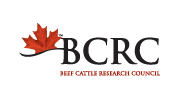Genetic evaluation of cattle raised under high vs. low input winter feeding systems
| Project Code: | FDE.06.17 |
| Completed: | In Progress. Results expected in March 2023. |
Project Title:
Genetic analyses of feed intake, feed efficiency, female fertility, and cow lifetime productivity in beef cattle raised under two environments
Researchers:
John Basarab Ph.D. and Changxi Li Ph.D. john.basarab@gov.ab.ca
John Basarab Ph.D. (University of Alberta); Changxi Li Ph.D. (Agriculture and Agri-Food Canada Edmonton); Carolyn Fitzsimmons Ph.D. (University of Alberta); Hushton Block Ph.D., Vern Baron Ph.D., Mohammad Khakbazan (Agriculture Agri-Food Canada); Graham Plastow Ph.D., Ghader Manafiazar Ph.D., John Crowley Ph.D. (Livestock Gentec); David Benfield Ph.D. (Growsafe); Kathy Larson (University of Saskatchewan)
Background:
Feed efficiency in a growing feedlot steer is a different trait than feed efficiency in a mature range cow, so selecting for one won’t necessarily improve the other. An animal won’t fully express its genetic potential unless it’s in a favorable environment. A favorable (high input) wintering environment may compensate for inferior genetics in heifers and cows that have above-average needs or below-average efficiency and allow them to regain condition and rebreed quickly enough to maintain a 365 day calving interval. In a tougher (low input) wintering environment, only the easy keeping, more efficient cows will be able to extract enough nutrition from their feed to maintain body condition, rebreed and maintain a 365-day calving interval.
Objectives:
To estimate genetic and phenotypic correlations of dry matter intake (DMI) and feed efficiency with heifer fertility, longevity and lifetime productivity (LTP) of cows reared under two winter feeding systems: Higher Inputs vs. Lower Inputs.
What They Will Do:
400 Angus-cross cows at AAFC Lacombe will be wintered from November to March in a drylot or on swath grazing. The breeding season will begin in June for both heifers (45 days) and cows 65 days). The University of Alberta’s Angus-based synthetic herd will also be managed in a drylot or fed lower quality hay supplemented with oats on range. Heifers will be bred for 50 days starting a month before the cow’s 60 day breeding season. Residual feed intake will be measured in heifers from 8 to 11 months of age, and heifer and cow weights, backfat, pregnancy status, calving dates and calf performance will be recorded.
The research team has previously collected residual feed intake data on 1,700 heifers and 289 cows, as well as 2838 matings in drylot or pasture settings. This project will generate additional data (1,000 heifer and 400 cow residual feed intake records and 2460 additional matings). All heifers and cows will be genotyped. Longevity and lifetime productivity will be determined, and genetic and phenotypic correlations between feed intake and efficiency, reproduction and total lifetime productivity will be calculated. Genetic relationships between cow and heifer performance will be determined. Genetic markers for these traits will be identified, and genetic, hybrid vigor and environmental effects will be calculated. Economic analyses will be conducted, and a multiple trait selection index will be developed. An additional 2,000 commercial heifers will be genotyped and measured for feed efficiency to develop commercial-level genetic evaluation indexes for heifer selection
Implications:
This project will determine whether genetics identified as “efficient” under feedlot conditions will produce cows with superior lifetime productivity when wintered under intensive drylot vs. extensive range conditions.








